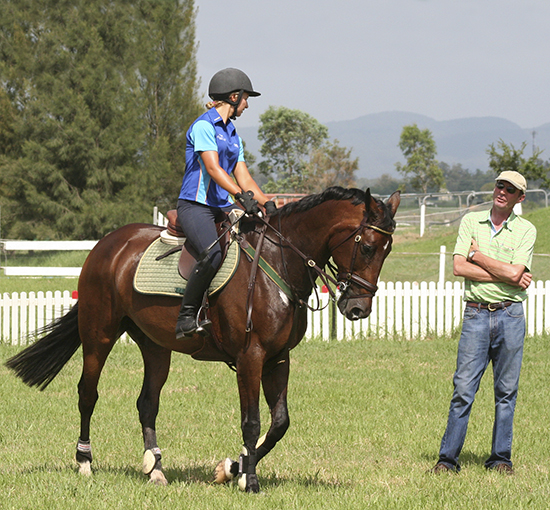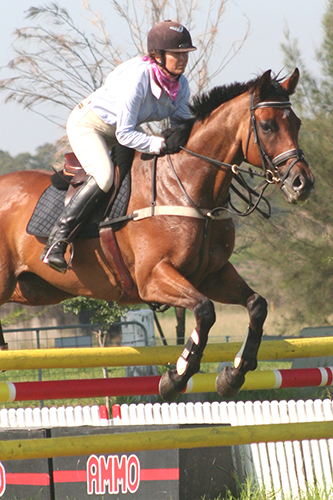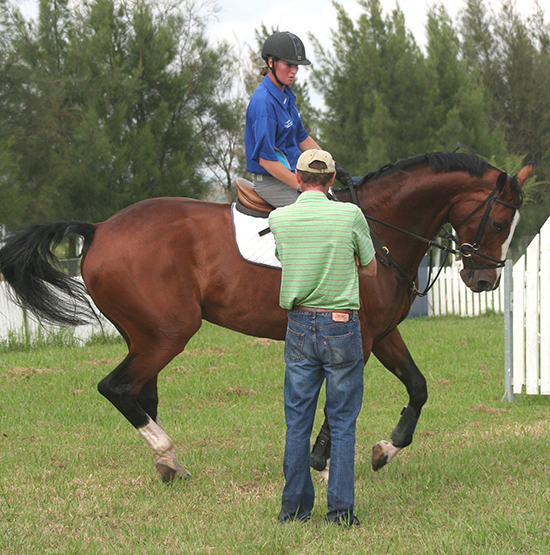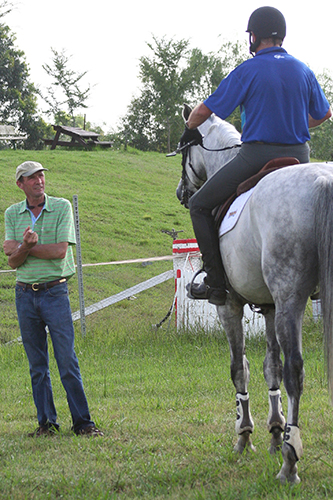 Story by Suzy Jarratt & Photos by Roger Fitzhardinge and Chrissie Johnson
Story by Suzy Jarratt & Photos by Roger Fitzhardinge and Chrissie Johnson
In recent times Australian equestrians have seen more coaches than a Greyhound Bus depot.
They have come from many lands at the request of equestrian bodies or private individuals. Have any had a lasting effect on the riders? Undoubtedly yes although there have been those who’ve come from Europe primarily to escape the winter or their wives, who’ve dispensed platitudes in exchange for dollars then hurried away.
Now the elite showjumpers of this country have Gilbert Böckmann, and with this coach they look as if they could be destined for a very beneficial, fulfilling journey.
During February he conducted a series of development clinics in Melbourne, Brisbane and Sydney for members of the National Jumping High Performance Program along with a number of promising riders in both eventing and showjumping from State and Young Rider Programs.
Based in Lastrup near Cloppenburg in Lower Saxony 47-year-old Gilbert, a father of two, is rated as one of the most talented jumping trainers in Europe. He sells, trains, breeds and competes, his top horse is the 9-year-old HGF Can Fly. He has a conscientious team working the 30 horses presently in his barn. The Böckmann centre attracts not only fellow Germans but riders from America, Italy and Mexico. Gilbert travels to all these countries conducting clinics, he came here to Equitana in 2005, and before arriving this time had been teaching in Dubai.
Colleen Brook riding Poets Corner
And no matter where he goes he encounters the same thing.
“The problem is the riders’ control of their horses. It doesn’t matter what gadgets and bits you use – none of that helps. When you build a house you have to start at the bottom, not the top. People have forgotten their flatwork. Yes it is boring and it’s hard work, under 1.20m you can probably do without it but if you want to go to 1.40m – 1.50m you need it or you will be killed,” he declared bluntly. His injuries have been few, a broken leg and one broken pinky.
His last days in Australia were spent at the Sydney Showjumping Club in Clarendon, the grounds of which he considered world class. He was impervious to the heat “I don’t notice it when I’m teaching”. He worked tirelessly but quietly, never grandstanding to spectators. Gilbert is a showjumper not a showman: a lean man who is never mean.
Judy Fasher, co-ordinator of the NSWIS elite jumping squad, praised his attitude.
“He’s very particular and precise. Riders must be able to control the length of their horse’s stride whatever they decide the appropriate length should be – it has to remain even. That’s not news to anybody but the way he gets it is by concentrating on the individual rider. Inside leg to outside rein; turning the horses with that outside rein. He makes a lot of use of 10 metre circles both as they land and as a settling exercise when executing a combination. If they get hot when they’re going over poles or in the line he makes them immediately go onto a 10 metre circle. He wants steady not pulling hands.”
“What I think is outstanding about him is he seems to find a way where he can help every individual rider achieve the exercise. He addresses riders in a non-aggressive, non-confronting way. That doesn’t mean he’s not effective, he certainly is, but he doesn’t make a big fuss about it. He doesn’t humiliate people even if they make repeated mistakes, he just tries to find another exercise which might help them solve the problem.”
Hilary Scott on Oaks Pro Ratina met the flatwork challenges well
In his thirty years of riding Gilbert has had many good trainers.
“And I think I’ve taken the best things from each of them,” he said as he took a brief break at the clubhouse overlooking the arenas. “Riding hasn’t changed in a hundred years but the horses have become more difficult. And now the jumps are more optical so you need more control and the fences are lighter – you have to ride a lot of half distances – five-and-a-half strides, six-and-a-half strides – you need to train at home – FLATWORK nothing else. Like driving a car – go forward, backwards, left and right, nothing else. Yes, yes,” he said defensively, as Rod Brown and he lit up, “smoking is bad I know.
“Look at those riders down there, already they have learnt a lot from yesterday,” he said, changing the subject.
But things might be different at an actual show.
“I’m only here to train them at the moment. I need to see them competing then I’ll have a better idea. Here it is very calm, at the show it is very different – the bell goes ding dong and you have one minute.”
He felt that the flatwork he had seen in Victoria and New South Wales was superior to that in Queensland.
Gilbert and Rod Brown with Corsica
“But I think it is only because the riders don’t have so many trainers in their state,”
No matter where showjumpers are in Australia there is room for improvement.
Rod Brown is adamant that if the sport grows and substantial sponsorship deals are made all riders will be wanting to get better: “They’ll be busting to train, and if they don’t they’ll get left behind.”
“You can chase cows one day and hoon around a 1.20m course the next – but as it goes up and the poles get lighter without good horses and training they’ll be left behind. We’ve done it here in the past. We’ve jumped up two steps and then it’s all ‘what for?’ – it’s easier to kick around at the lower levels.”
“There are a few things Gilbert’s saying which have hit home more than before – connection is one of them. It’s been a slightly elusive thing. We must keep the horse more consistent – we mustn’t be giving all the time only when it is totally necessary. The horse becomes lighter and is able to be ridden up to the hand – his explanation has been very good.
“He’s been great for me. The horse I’m riding, Corsica Z, is by Cathargo Z. Gilbert said to me that they’re all the same. You see a distance and relax, the next thing you’ve passed the spot and lost the front end.”
“I’ve been doing this a long time but I don’t understand the Warmbloods of today. They’ve got more blood in them, unlike the clumpers which came out in the early days. They’re stiff when they’re young and a bit all over the place. Left to my own devices I would have continued riding mine wrongly. Now I know what to do and it’s been a super result.”
“Michelle Strapp had told me how wonderful the clinic was which she did with Gilbert when he was in Melbourne a couple of years ago. I’m pleased he came back.”
“George Morris did a great job in years past but in my opinion we’re overdue for some European influence. The horses we’re on now are European style or European bred so we need to know how to ride them like the Europeans do.”
Vicki Roycroft, as National Jumping Chair, was instrumental in Gilbert’s coming to Australia.
“To me George Morris is the ultimate trainer but he doesn’t suit everybody’s taste. I credit him for my success, I like people to get about me but a lot of other people don’t. George is capable of offending some people, Gilbert is much more laid back. I don’t think he’s telling me anything new but he’s reinforcing, he is eyes on the ground and I’m a clinic junky anyway.”
“I’m quietly optimistic about this guy, he seems to have a genuine enthusiasm about doing this job whereas, for some of the others in the past, there were various other incentives or disincentives.”
Showjumping sage George Sanna is of the opinion that the senior coaches in this country, good as they may be, are still riding and many are involved in the elite squad.
“This makes a difference – the politics of people knowing each other, competing against each other and then having one of them as their coach – it just can’t work even with all the best intentions in the world. You need someone from the outside with whom everyone is comfortable, whose methods, personality and approach are acceptable – it really is the only way.”
After a High Performance meeting which took place straight after the Sydney clinic it was decided that the panel and Gilbert had arrived at an amicable arrangement.
“He’s very keen,” a delighted Rod Brown told The Horse Magazine, “he’s given us the thumbs up and will be back in July,”
Showjumpers around Australia you know what you have to do – flat work…. flatwork….flatwork….
This article first appeared in THM April 2007.




